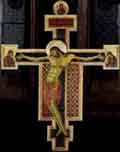 Cenni of Pepo, known as Cimabue, was born in Florence in about 1240. There is little reliable information on his youth and it is difficult to establish the chronology of his works. However, from the information available, a clear picture of his personality has been drawn.
Cenni of Pepo, known as Cimabue, was born in Florence in about 1240. There is little reliable information on his youth and it is difficult to establish the chronology of his works. However, from the information available, a clear picture of his personality has been drawn.
Cimabue worked in a period whenart was still tied to Byzantine classicism yet he managed to create his own personal style, which he used to depict holy events in a more realistic way.
Some of his first works, like the Crucifix of St Domenico in Arezzo, was probably painted between 1265 and 1268, and the Crucifix of Santa Croce in Florence, are both clearly linked to Byzantine art but both clearly show an effort to overcome and change the traditional Byzantine conventions.
In about 1270 he painted the Maestà (today in the Louvre); the attempt to go beyond formal Byzantine abstraction is clearly visible here, even if the Madonna seems to hover instead of sit on the throne and there are narrow folds in her clothes.
 Between 1277 and 1280 Cimabue was inAssisi where he worked on the upper basilica. He painted the frescos of the vaults and the transept walls; specifically, he painted: Evangelists in the vault of the cross, Life of the Virgin in the chorus, Scenes from the Apocalypse, the Last Judgement and Crucifixion in the left part of the transept, Life of St Peter in the right. The fresco of the Madonna, St Francis and angels, in the lower Basilica and St Francis (now in the museum of the Basilica of Santa Maria degli Angels) date to the same period.
Between 1277 and 1280 Cimabue was inAssisi where he worked on the upper basilica. He painted the frescos of the vaults and the transept walls; specifically, he painted: Evangelists in the vault of the cross, Life of the Virgin in the chorus, Scenes from the Apocalypse, the Last Judgement and Crucifixion in the left part of the transept, Life of St Peter in the right. The fresco of the Madonna, St Francis and angels, in the lower Basilica and St Francis (now in the museum of the Basilica of Santa Maria degli Angels) date to the same period.
Maestà di Santa Trinità (today in the Uffizi) probably dates to 1279. The painting’s composition is frontal and symmetrical, even if the Madonna looks more human because the typically abstract Byzantine features are missing in this figure.
Maestà della chiesa dei Servi in Bologna and the mosaic of St John in the Duomo of Pisa (1301) were painted after 1279.
Cimabue died in Pisa in 1302.